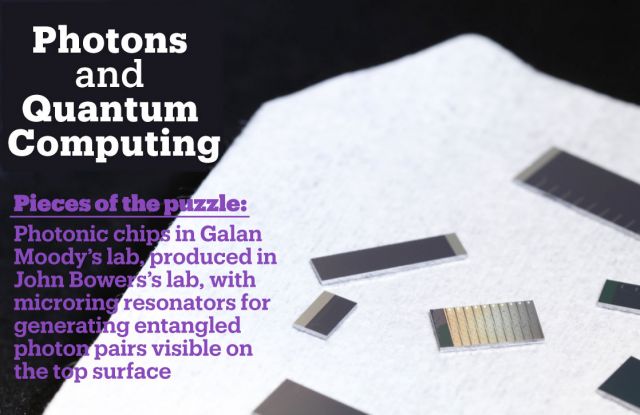Moody "Photons & Quantum Computing"
ECE Ass't. Prof. Galan Moody receives a grant to pursue a photonic-based platform for quantum processing

ECE Ass't. Prof. Galan Moody receives a new grant to pursue a photonic-based platform for quantum processing
Excerpt from CoE Convergence (S21) article "Photons and Quantum Computing"
Classical computing is built upon the power of the bit, which is, in essence, a microtransistor on a chip that can either be on or off, representing a 1 or a 0 in binary code. The quantum computing equivalent is the qubit. Unlike bits, qubits can be in more than one “state” at a time, enabling quantum computers to perform computational functions exponentially faster than classical computers can.
To date, most efforts to build quantum computers have relied on qubits created in superconducting wires chilled to near absolute zero or trapped ions held in place by lasers. But those approaches face certain challenges, most notably that the qubits are highly sensitive to environmental factors. As the number of qubits increases, those factors are more likely to compound and interrupt the entanglement of qubits required for a quantum computer to work.
Another approach that has been developed more recently is to use a photon as an optical qubit to encode quantum information and to integrate the components 22 necessary for that process onto a photonic integrated circuit (PIC). Recently, Galan Moody, an assistant professor in the UC Santa Barbara College of Engineering’s Department of Electrical and Computer Engineering, received a Defense University Research Instrumentation Program (DURIP) Award from the U.S. Department of Defense and the Air Force Office of Scientific Research. The grant will allow him to build a quantum photonic computing testbed, conducting his research in a lab set aside for such activity in recently completed Henley Hall, the new home of the CoE’s Institute for Energy Efficiency.
The grant supports the development or acquisition of new instrumentation to be used in fundamental and applied research across all areas of science and engineering. “In my field, it’s quantum photonics, so we’re working to develop new types of quantum light sources and ways to manipulate and detect quantum states of light for use in such applications as quantum photonic computing and quantum communications,” Moody says.
“At the high level,” he explains, the concept of quantum photonic computing is “exactly the same as what Google is doing with superconducting qubits or what other companies are doing with trapped ions. There are a lot of different platforms, and one of them is to use photonic integrated circuits to generate entangled photons, entanglement being the foundation for multiple quantum applications.”
To place an entire quantum photonics system onto a chip measuring about one square centimeter would be a tremendous achievement. Fortunately, the well-developed photonics infrastructure — including AIM Photonics, which has a center at UCSB led by professor and photonics pioneer John Bowers — lends itself to that pursuit and to scaling up whatever quantum photonics platform is most promising. Photonics for classical applications is a mature technology industry that, Moody says, “has basically mastered large-scale and wafer-scale processing and fabrication of devices.” It is reliable, so whatever Moody and his team design, they can fabricate themselves or even order from foundries, knowing that they will get exactly what they want.
Learn more:
- The Photonic Edge
- Platform & Process
COE/CLS Convergence magazine (S21) – "Photons and Quantum Computing" (full article pg. 22)